
Nitrate Leaching: an Interactive Tool
Created by Irfan Ainuddin, Patricia Lazicki and Daniel Geisseler*
Javascript is disabled on your browser. For full functionality of this site it is necessary to enable JavaScript. Follow this link for instructions on how to enable JavaScript in your web browser.
Rooting depth
Growth stage
Irrigation type
Soil texture
Residual soil nitrate
Irrigation level
This tool shows how plants, soil and water interact to affect nitrate leaching. To get started, select one option in each category and press "Show Results". To explore how changing a factor affects nitrate leaching risk, choose another combination and press “Show Results” again.

Light, frequent irrigations are less likely to leach nitrate past the small root zones of young plants than heavy irrigations. The leaching risk is lower in fine-textured soils, since they have a higher water holding capacity than sandy soils.
Placing starter fertilizer near the plant line ensures that the small roots have access to N for early development when N demand is still low.
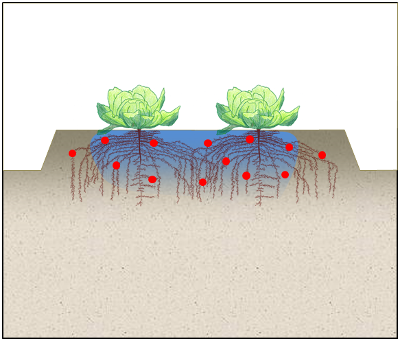
Light, frequent irrigations are less likely to leach nitrate past the root zones of shallow-rooted plants than heavy irrigations. The leaching risk is lower in fine-textured soils, since they have a higher water holding capacity than sandy soils.
Soil samples for nitrate testing should be taken within the wetting zone, since plants will only take up N from moist soil.

A light irrigation to refill the active root zone will minimize the risk of nitrate leaching past the small roots of young plants. The leaching risk is lower in fine-textured soils, since they have a higher water holding capacity than sandy soils.
Placing starter fertilizer near the plant line ensures that the small roots have access to N for early development when N demand is still low. Some nitrate and salts may accumulate in the middle of the bed under furrow irrigation.
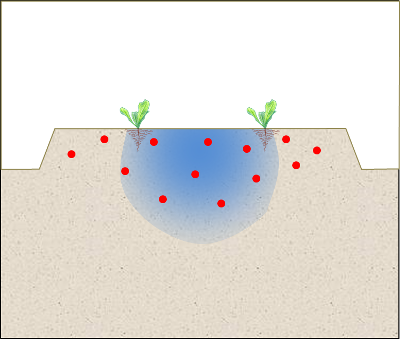
Light, frequent irrigations are less likely to leach nitrate past the small root zones of young plants than heavy irrigations. Leaching is more likely on sandy soils since the water drains quickly and sandy soils have a low water holding capacity.
Placing starter fertilizer near the plant line ensures that the small roots have access to N for early development when N demand is still low.
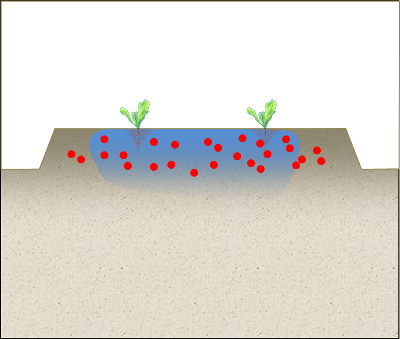
When the soil nitrate levels are high, careful irrigation management is especially important to minimize the risk of leaching when the crops don't have an extensive root system and N uptake by young plants is low. Light, frequent irrigations are less likely to leach nitrate past the small root zones of young plants than heavy irrigations. The leaching risk is lower in fine-textured soils, since they have a higher water holding capacity than sandy soils.
Residual nitrate should be counted towards a crop’s total N requirement. A small starter application containing ammonium and phosphorus placed near the plant roots may stimulate root growth. However, the amount of N applied should be low.
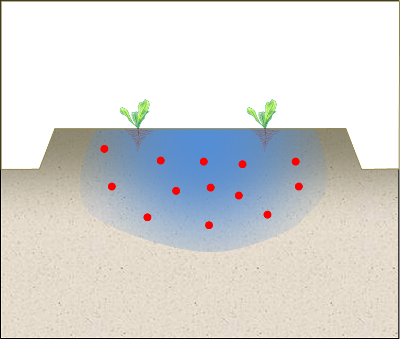
Soils can become waterlogged when heavy irrigations are made to young plants in fine-textured soils, since the soils don’t drain easily and the crops don't take up much water yet. Root N uptake is impaired and soil N may be lost to the atmosphere (denitrification) or leached to the groundwater. Ammonium fertilizers are less likely to be lost by denitrification than nitrate fertilizers in wet soil.
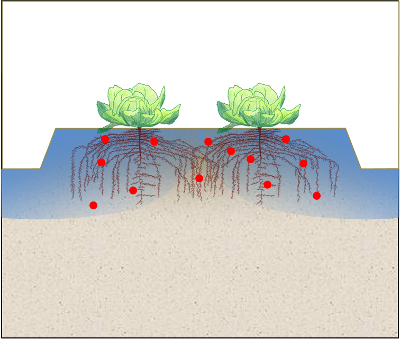
Light irrigations to refill the active root zone will help ensure nitrate doesn’t leach past the rooting zone of shallow-rooted crops. The leaching risk is lower in fine-textured soils, since they have a higher water holding capacity than sandy soils. Nitrate and salts may accumulate in the middle of the bed under furrow irrigation.
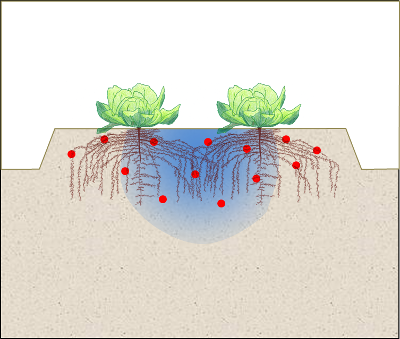
Light, frequent irrigations are less likely to leach nitrate past the small root zones of shallow-rooted plants than heavy irrigations. Leaching is more likely on sandy soils since the water drains quickly and sandy soils have a low water holding capacity.
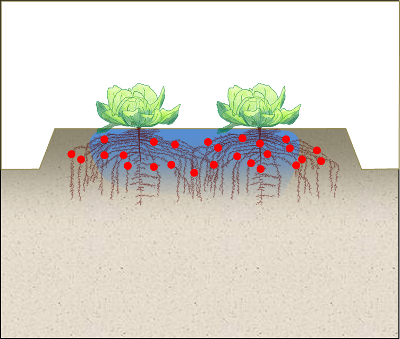
When the soil nitrate levels are high, careful irrigation management is especially important to minimize the risk of leaching with shallow-rooted crops.
Residual nitrate should be counted towards a crop's total N requirement. Soil samples for nitrate testing should be taken within the wetting zone, since plants will only take up N from moist soil.
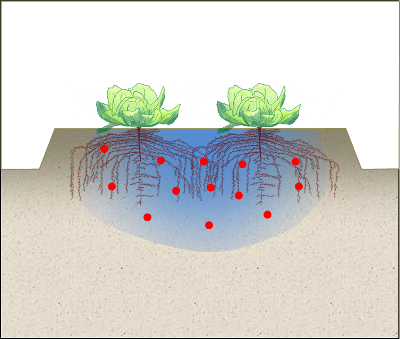
Heavy irrigations are less risky in fine textured since they have a higher water holding capacity than sandy soils. However, irrigation should not exceed predicted water uptake by evapotranspiration (ET) to avoid the risk of waterlogging or leaching past the shallow root systems.
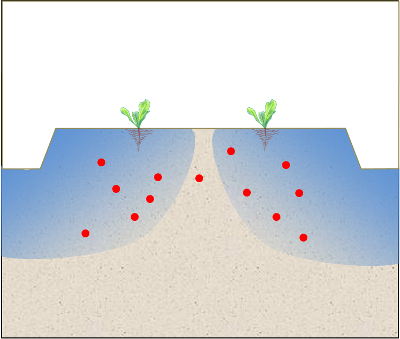
Leaching is more likely on sandy soils since the water drains quickly and sandy soils have a low water holding capacity. Light applications based on evapotranspiration (ET) that are just sufficient to refill the active root zone reduce these losses.
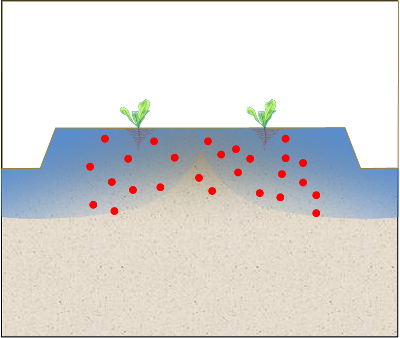
When the soil nitrate levels are high, careful irrigation management is especially important to minimize the risk of leaching with young shallow-rooted crops. The leaching risk is lower in fine-textured soils, since they have a higher water holding capacity than sandy soils. Nitrate and salts may accumulate in the middle of the bed under furrow irrigation. A small starter application containing ammonium and phosphorus placed near the plant roots may stimulate root growth. However, the amount of N applied should be low. Residual nitrate should be counted towards a crop's total N requirement.
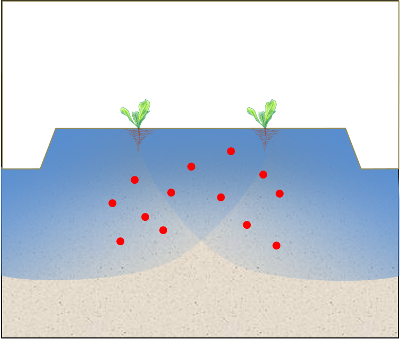
Soils can become waterlogged when heavy irrigations are made to young plants in fine-textured soils, since the soils don't drain easily and the crops don't take up much water yet. Root N uptake is impaired and soil N may be lost to the atmosphere (denitrification) or leached to the groundwater.
Ammonium fertilizers are less likely to be lost by denitrification than nitrate fertilizers in wet soil.
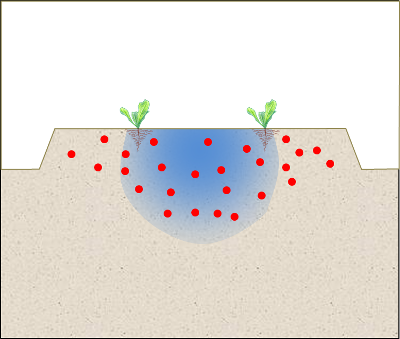
When the soil nitrate levels are high, careful irrigation management is especially important to minimize the risk of leaching when the crops don't have an extensive root system and N uptake by young plants is low. In addition, leaching is more likely on sandy soils since the water drains quickly and sandy soils have a low water holding capacity.
A small starter application containing ammonium and phosphorus placed near the plant roots may stimulate root growth. However, the amount of N applied should be low. Residual nitrate should be counted towards a crop’s total N requirement.
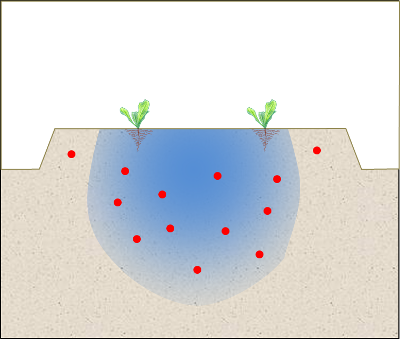
Heavy irrigations risk leaching nitrate past the root zone of young, shallow-rooted plants. The leaching risk is highest in sandy soils, which do not hold water well.
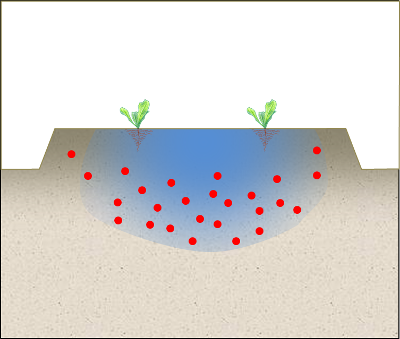
Soils can become waterlogged when heavy irrigations are made to young plants in fine-textured soils, since the soils don't drain easily and the crop can't take up much water yet. Root N uptake is impaired and soil N may be lost to the atmosphere (denitrification) or leached to the groundwater.
Residual nitrate should be counted towards a crop's total N requirement.
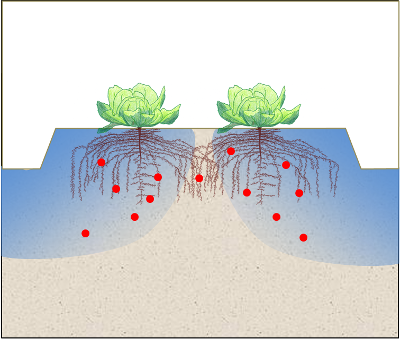
Nitrate is especially at risk of loss by leaching on sandy soils, since they do not hold water well. Light applications that are just sufficient to refill the active root zone reduce these losses. Nitrate and salts may accumulate in the middle of the bed under furrow irrigation.
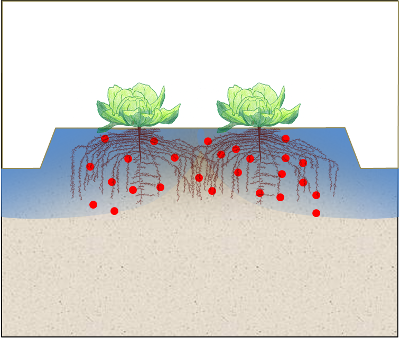
When the soil nitrate levels are high, careful irrigation management is especially important to minimize the risk of leaching below the root zone of shallow-rooted crops. The leaching risk is lower in fine-textured soils, since they have a higher water holding capacity than sandy soils.
Residual nitrate should be counted towards a crop's total N requirement.
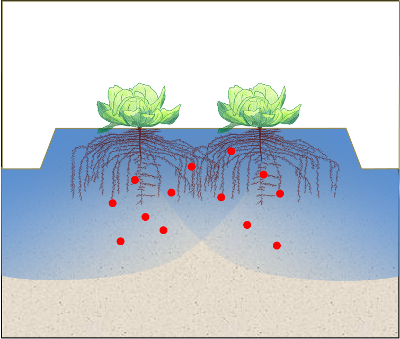
Heavy irrigations to shallow-rooted crops may leach nitrate below the root zone. It’s important to match irrigation level to expected crop water uptake.
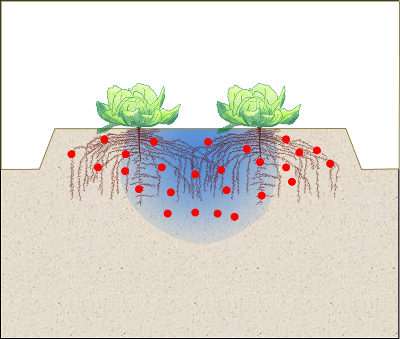
When the soil nitrate levels are high, careful irrigation management is especially important to minimize the risk of leaching below the root zone of shallow-rooted crops. In addition, leaching is more likely on sandy soils since the water drains quickly and sandy soils have a low water holding capacity.
Residual nitrate should be counted towards the crop’s total N requirement.
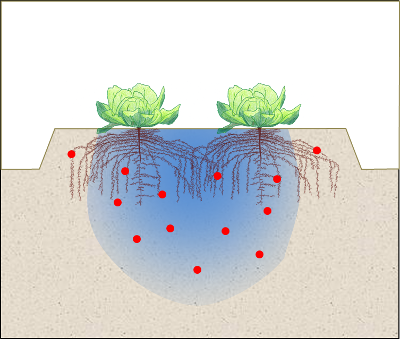
Heavy irrigations risk leaching nitrate past the root zone of shallow-rooted plants. The leaching risk is highest in sandy soils, which do not hold water well.

Heavy irrigations risk leaching nitrate past the root zone shallow-rooted plants. The leaching risk is lower in heavy soils than sandy soils, since they don’t drain as quickly. When the soil nitrate levels are high, careful irrigation management is especially important to minimize the risk of leaching below the root zone of shallow-rooted crops.
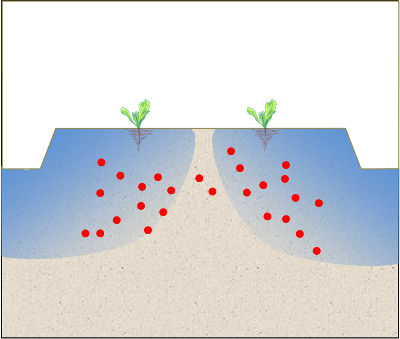
When the soil nitrate levels are high, careful irrigation management is especially important to minimize the risk of leaching when the crops don't have an extensive root system and N uptake by young plants is low. In addition, leaching is more likely on sandy soils since the water drains quickly and sandy soils have a low water holding capacity. Light applications that are just sufficient to refill the active root zone reduce these losses. Nitrate and salts may accumulate in the middle of the bed under furrow irrigation.
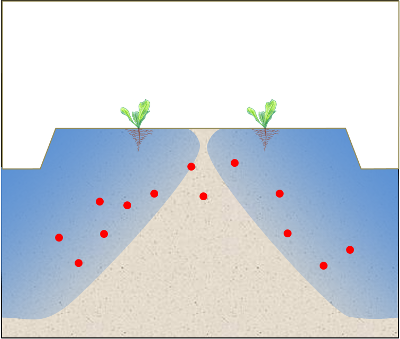
Heavy irrigations on sandy soils will leach nitrate past the root zone of young, shallow-rooted plants. Light applications that are just sufficient to refill the active root zone reduce these losses.
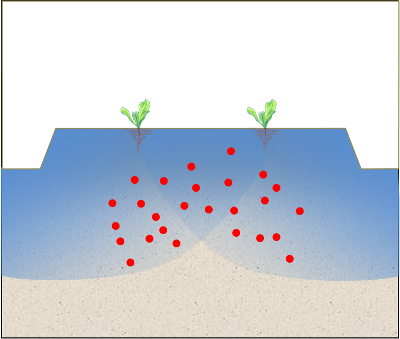
Soils can become waterlogged when heavy irrigations are made to young plants in fine-textured soils, since the soils don't drain easily and the crops don't take up much water yet. Root N uptake is impaired and soil N may be lost to the atmosphere (denitrification) or leached to the groundwater. Ammonium fertilizers are less likely to be lost by denitrification in wet soil than nitrate fertilizers.
Residual nitrate should be counted towards a crop's total N requirement.
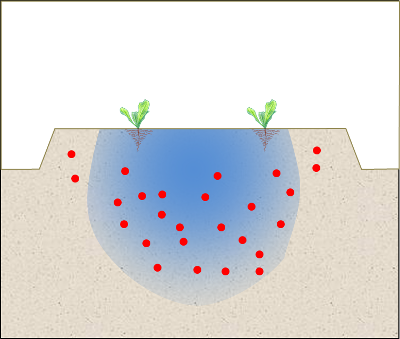
Heavy irrigations risk leaching nitrate past the root zone of young, shallow-rooted plants. The leaching risk is highest in sandy soils, which do not hold water well. When the soil nitrate levels are high, careful irrigation management is especially important to minimize the risk of leaching when the crops don't have an extensive root system and N uptake by young plants is low.
Residual nitrate should be counted towards a crop's total N requirement.

When the soil nitrate levels are high, careful irrigation management is especially important to minimize the risk of leaching below the root zone of shallow-rooted crops. In addition, leaching is more likely on sandy soils since the water drains quickly and sandy soils have a low water holding capacity.
Residual nitrate should be counted towards a crop's total N requirement. Irrigations in excess of crop needs may leach this nitrate beyond the root zone of a shallow-rooted crop.

Heavy irrigations on sandy soils can leach nitrate past the root zone of shallow-rooted plants. Light applications that are just sufficient to refill the active root zone reduce these losses.
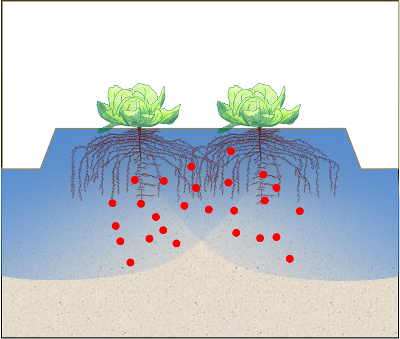
Irrigations in excess of crop needs may leach nitrate beyond the root zone of a shallow-rooted crop, or cause waterlogging in soils that don’t drain well. This can impair root function and may cause nitrogen loss to the atmosphere by denitrification or leached to the groundwater. When the soil nitrate levels are high, careful irrigation management is especially important to minimize the risk of leaching below the root zone of shallow-rooted crops.
Residual nitrate should be counted towards a crop's total N requirement.
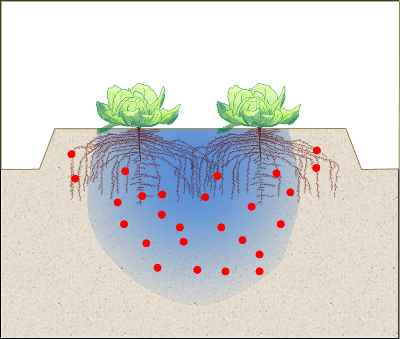
Heavy irrigations risk leaching nitrate past the root zone of shallow-rooted plants. The leaching risk is highest in sandy soils, which do not hold water well. When the soil nitrate levels are high, careful irrigation management is especially important to minimize the risk of leaching below the root zone.
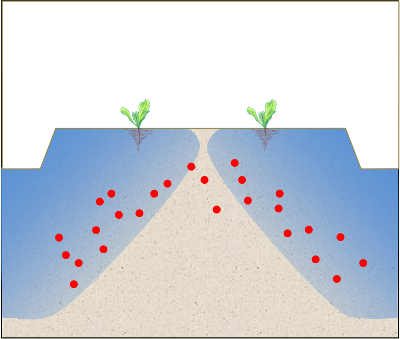
Heavy irrigations on sandy soils will leach nitrate past the root zone of young, shallow-rooted plants. Light applications that are just sufficient to refill the active root zone reduce these losses. When the soil nitrate levels are high, careful irrigation management is especially important to minimize the risk of leaching when the crops don't have an extensive root system and N uptake by young plants is low. In addition, leaching is more likely on sandy soils since the water drains quickly and sandy soils have a low water holding capacity.
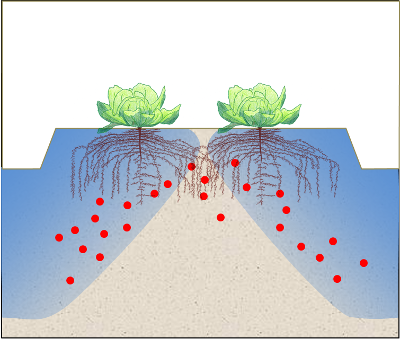
Heavy irrigations on sandy soils will leach nitrate past the root zone of shallow-rooted plants. Light applications that are just sufficient to refill the active root zone reduce these losses. When the soil nitrate levels are high, careful irrigation management is especially important to minimize the risk of leaching below the root zone. In addition, leaching is more likely on sandy soils since the water drains quickly and sandy soils have a low water holding capacity.
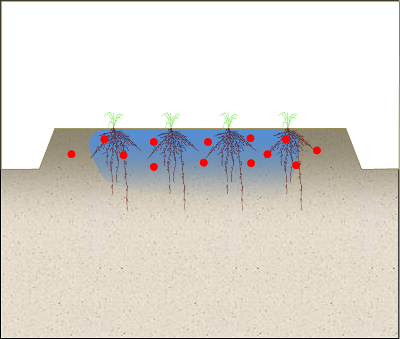
Small, frequent irrigations help ensure soil nitrate doesn’t leach past the root zone of young plants. While a deep rooted crop may recover the N later, early deficiencies may reduce yields. Nitrate is only taken up from the wetting zone.
Placing starter fertilizer near the plant line ensures that the small roots have access to N for early development when N demand is still low.

Mature deep rooted crops can take up nitrate from deeper soil layers, greatly reducing the risk of nitrate leaching. As plants only take up N from moist soil, less frequent but heavier irrigations may increase the area of soil they can exploit. However, even though the risk of leaching is low, irrigation levels should not exceed crop water demand.
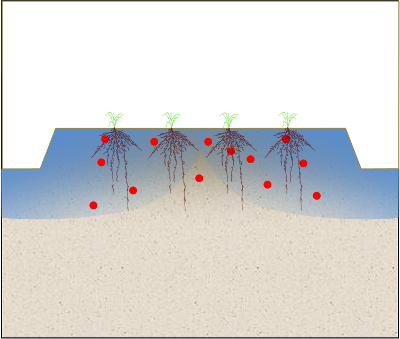
A light irrigation to refill the active root zone will minimize the risk of nitrate leaching past the small roots of young plants. The leaching risk is lower in fine-textured soils, since they have a higher water holding capacity than sandy soils.
Placing starter fertilizer near the plant line ensures that the small roots have access to N for early development when N demand is still low. Some nitrate and salts may accumulate in the middle of the bed under furrow irrigation.
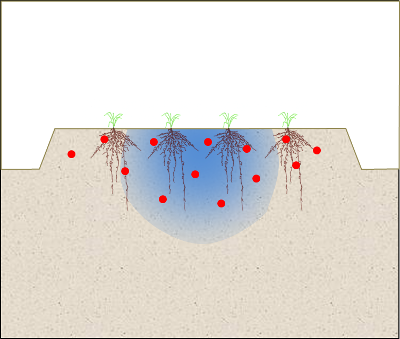
Light, frequent irrigations are less likely to leach nitrate past the small root zones of young plants than heavy irrigations. Leaching is more likely on sandy soils since the water drains quickly and sandy soils have a low water holding capacity.
Placing starter fertilizer near the plant line ensures that the small roots have access to N for early development when N demand is still low.
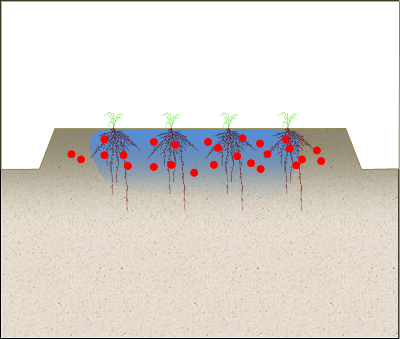
When the soil nitrate levels are high, careful irrigation management is especially important to minimize the risk of leaching when the crops don't have an extensive root system and N uptake by young plants is low.
Light, frequent irrigations are less likely to leach nitrate past the root zones of young plants than heavy irrigations. The leaching risk is lower in fine-textured soils, since they have a higher water holding capacity than sandy soils. Residual nitrate should be counted towards a crop’s total N requirement.
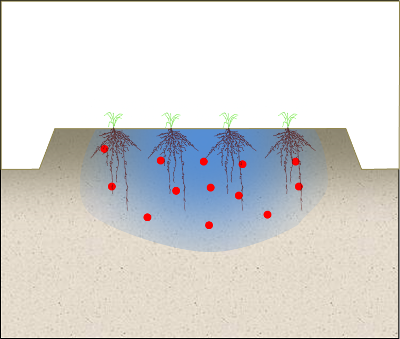
Soils can become waterlogged when heavy irrigations are made to young plants in fine-textured soils, since the soils don’t drain easily and the crops don’t take up much water yet. Root N uptake is impaired and soil N may be lost to the atmosphere (denitrification) or leached to the groundwater. Ammonium fertilizers are less likely to be lost by denitrification than nitrate fertilizers in wet soil.
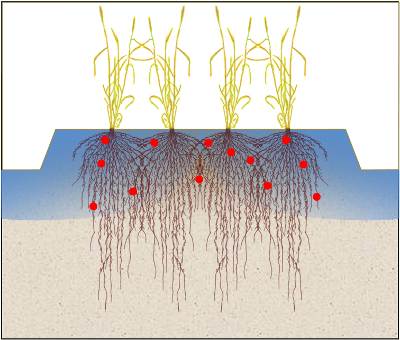
In fine textured soil, leaching beyond the root zone of mature, deep-rooting crops is not likely as long as irrigation does not exceed predicted water uptake by evapotranspiration (ET).
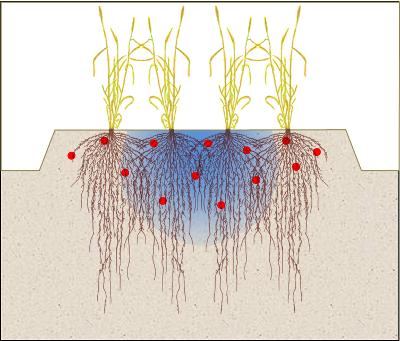
Leaching is more likely on sandy soils since the water drains quickly and sandy soils have a low water holding capacity. However, the risk of leaching beyond the root zone of mature, deep-rooting crops is low as long as irrigation does not exceed predicted water uptake by evapotranspiration (ET).
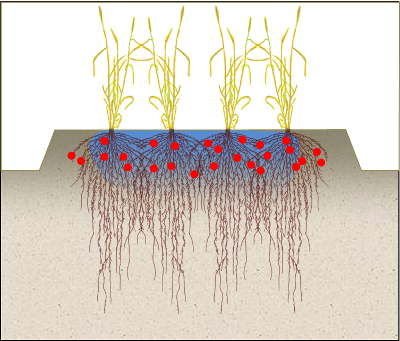
Mature deep rooted crops can take up nitrate from deeper soil layers, greatly reducing the risk of nitrate leaching. As plants only take up N from moist soil, less frequent but heavier irrigations may increase the area of soil they can exploit. However, even though the risk of leaching is lower with deep-rooted crops, irrigation levels should not exceed crop water demand, especially when soil nitrate levels are high.
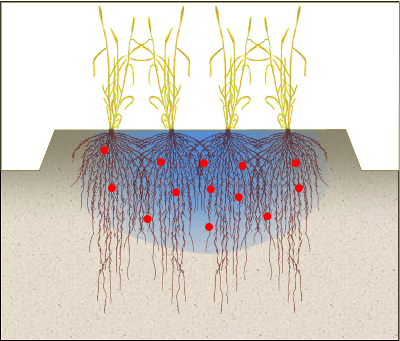
Heavy irrigations are less risky in fine textured soils than in sandy soils since fine textured soils have a higher water holding capacity. However, even with deep rooted crops, irrigation should not exceed predicted water uptake by evapotranspiration (ET).

Leaching is more likely on sandy soils since the water drains quickly and sandy soils have a low water holding capacity. Light applications based on evapotranspiration (ET) that are just sufficient to refill the active root zone reduce these losses.
Placing starter fertilizer near the plant line ensures that the small roots have access to N for early development when N demand is still low.
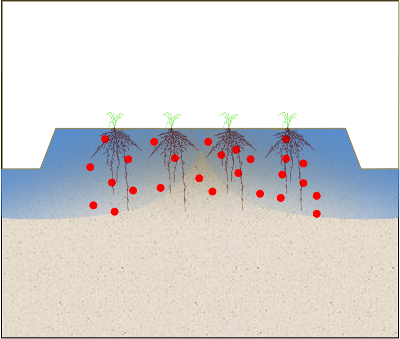
When the soil nitrate levels are high, careful irrigation management is especially important to minimize the risk of leaching with young crops that don't have an extensive root system yet. The leaching risk is lower in fine-textured soils, since they have a higher water holding capacity than sandy soils. Nitrate and salts may accumulate in the middle of the bed under furrow irrigation. A small starter application containing ammonium and phosphorus placed near the plant roots may stimulate root growth. However, the amount of N applied should be low.
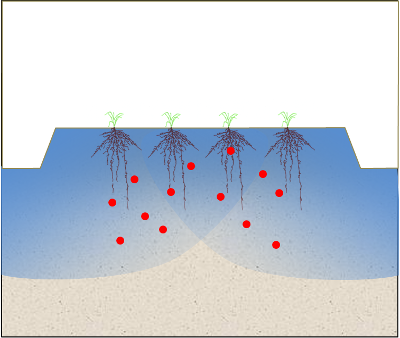
Soils can become waterlogged when heavy irrigations are made to young plants in fine-textured soils, since the soils don't drain easily and the crop can't take up much water yet. Root N uptake is impaired and soil N may be lost to the atmosphere (denitrification) or leached to the groundwater.
Ammonium fertilizers are less likely to be lost by denitrification than nitrate fertilizers in wet soil.
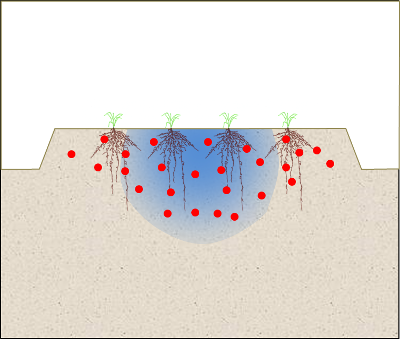
When the soil nitrate levels are high, careful irrigation management is especially important to minimize the risk of leaching when the crops don't have an extensive root system and N uptake by young plants is low. In addition, leaching is more likely on sandy soils since the water drains quickly and sandy soils have a low water holding capacity. Deep rooted crops may be able to take up some of the nitrate in deeper layers later in the season.
A small starter application containing ammonium and phosphorus placed near the plant roots may stimulate root growth. However, the amount of N applied should be low. Residual nitrate should be counted towards a crop's total N requirement.
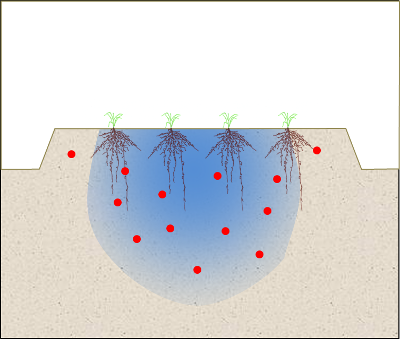
Heavy irrigations risk leaching nitrate past the root zone of young plants. The leaching risk is highest in sandy soils, which do not hold water well. Deep rooted crops may be able to take up some of the nitrate in deeper layers later in the season.
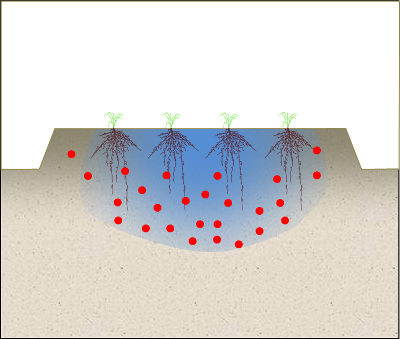
However, soils can become waterlogged when heavy irrigations are made to young plants in fine-textured soils, since the soils don't drain easily and the crop can't take up much water. Root N uptake is impaired and soil N may be lost to the atmosphere (denitrification) or leached to the groundwater.
Residual nitrate should be counted towards a crop's total N requirement.
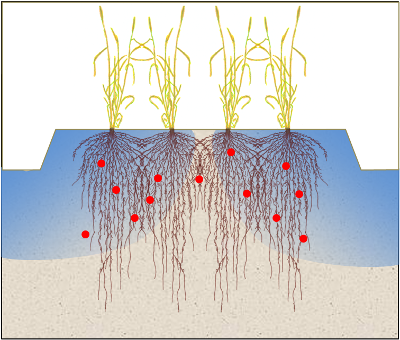
Irrigations should be sufficient to refill the active root zone and should not exceed predicted water uptake by evapotranspiration (ET). For deep rooted crops heavier, less frequent irrigations may increase the area of soil they can exploit. Good irrigation uniformity reduces risk of nitrate leaching with heavy irrigations.
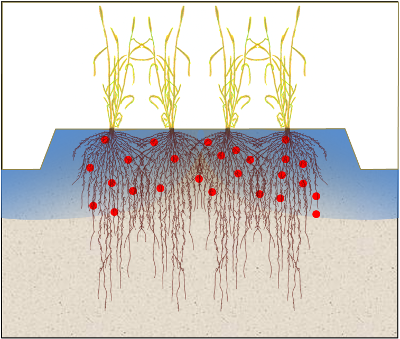
For deep rooted crops heavier, less frequent irrigations may increase the area of soil they can exploit. In fine textured soil, leaching beyond the root zone isn’t likely as long as irrigation does not exceed predicted water uptake by evapotranspiration (ET). Nitrate and salts may accumulate in the middle of the bed under furrow irrigation.
Residual nitrate should be counted towards a crop's total N requirement.
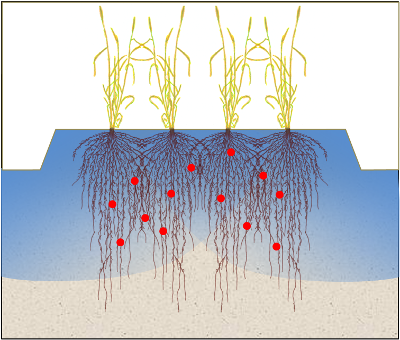
Irrigations should be sufficient to fill the active rooting zone. While leaching below the root zone of deep rooted crops is less of an issue, irrigations in excess of crop needs on clay soils may lead to waterlogging, which impairs root function and can cause N loss to the atmosphere (denitrification). Good irrigation uniformity reduces this risk.
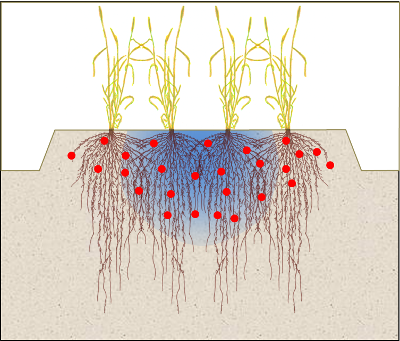
For deep rooted crops heavier, less frequent irrigations may increase the area of soil they can exploit. However, even though the risk of leaching is lower with deep-rooted crops, irrigation levels should not exceed crop water demand.
Residual nitrate should be counted towards a crop's total N requirement.
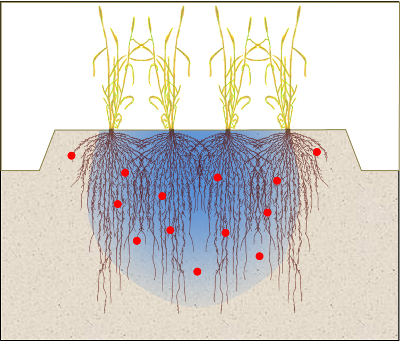
Heavy irrigations on sandy soils can leach nitrate past the root zone even of deep-rooted plants. For deep rooted crops heavier, less frequent irrigations may increase the area of soil they can exploit. However, even though the risk of leaching is lower with deep-rooted plants, irrigation levels should not exceed crop water demand.
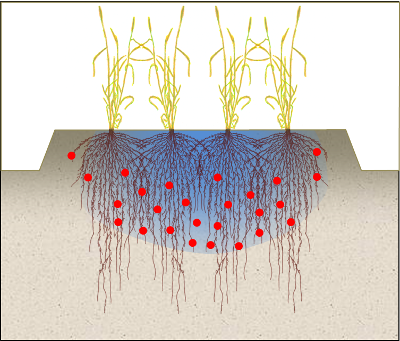
For deep rooted crops heavier, less frequent irrigations may increase the area of soil they can exploit. However, irrigations should match predicted crop uptake.
Residual nitrate should be counted towards a crop's total N requirement.

When the soil nitrate levels are high, careful irrigation management is especially important to minimize the risk of leaching when the crops don't have an extensive root system and N uptake by young plants is low. In addition, leaching is more likely on sandy soils since the water drains quickly and sandy soils have a low water holding capacity. Salts and nitrate may accumulate near the middle of the bed in fine-textured soils.
Residual nitrate should be counted towards a crop's total N requirement.
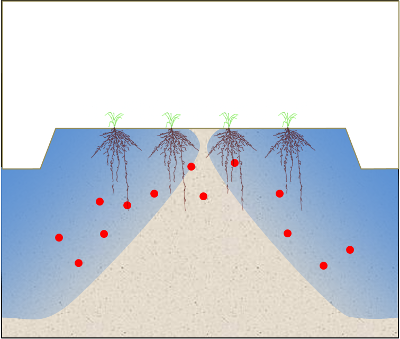
Heavy irrigations on sandy soils can leach nitrate past the root zone of young plants. Good irrigation uniformity reduces this risk.
Placing a little starter fertilizer near the plant line may improve root access to N.
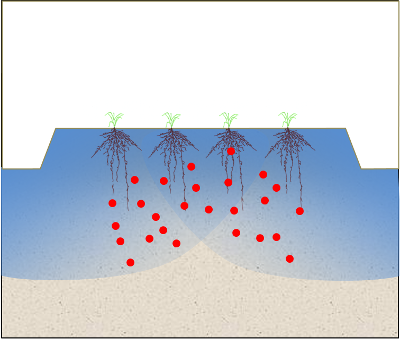
Soils can become waterlogged when heavy irrigations are made to young plants in fine-textured soils, since the soils don't drain easily and the crops don't take up much water yet. Root N uptake is impaired and soil N may be lost to the atmosphere (denitrification) or leached to the groundwater.
Residual nitrate should be counted towards a crop's total N requirement.
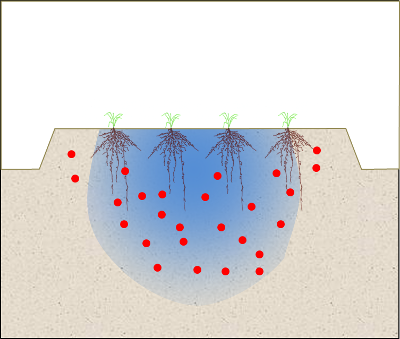
Heavy irrigations risk leaching nitrate past the root zone of young plants. The leaching risk is highest in sandy soils, which do not hold water well.
Residual nitrate should be counted towards a crop's total N requirement.
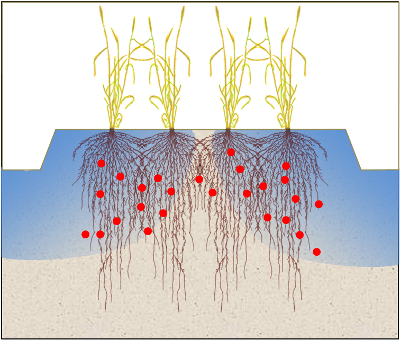
For deep rooted crops heavier, less frequent irrigations may increase the area of soil they can exploit. However, even though the risk of leaching is lower with deep-rooted crops, irrigation levels should not exceed crop water demand.
Residual nitrate should be counted towards a crop's total N requirement.

Heavy irrigations on sandy soils can leach nitrate past the root zone even of deep-rooted plants. Good irrigation uniformity reduces this risk. However, even with good water management, less of the applied N is normally captured with sandy soils (N use efficiency is lower).
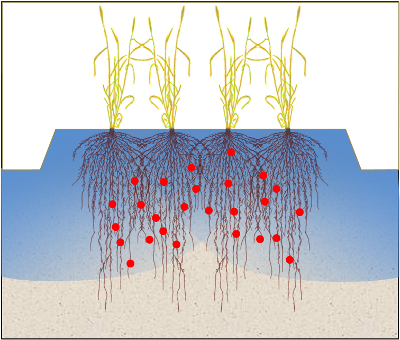
Soils can become waterlogged when irrigations in excess of crop need are made in fine-textured soils, since the soils don’t drain easily. Root nutrient uptake can be impaired and soil N may be lost to the atmosphere (denitrification). Even though the risk of leaching is lower with deep-rooted crops, irrigation levels should not exceed crop water demand.
Residual nitrate should be counted towards a crop's total N requirement.

Heavy irrigations on sandy soils can leach nitrate past the root zone even of deep-rooted plants. Irrigation levels should not exceed crop water demand, especially when soil nitrate levels are high.
Residual nitrate should be counted towards a crop's total N requirement.
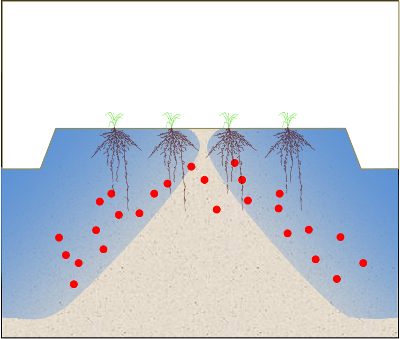
Irrigations in excess of crop needs may leach this nitrate beyond the root zone of young plants, especially in sandy soils. Good irrigation uniformity reduces this risk.
Residual nitrate should be counted towards a crop's total N requirement.
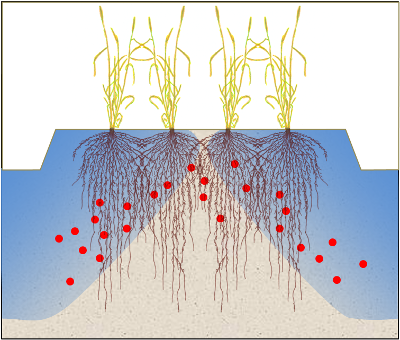
Heavy irrigations on sandy soils can leach nitrate past the root zone even of deep-rooted plants. Good irrigation uniformity reduces this risk. Irrigation levels should not exceed crop water demand.
Residual nitrate should be counted towards a crop's total N requirement.
* Irfan Ainuddin is a Junior Specialist in the Department of Land, Air and Water Resources at the University of California, Patricia Lazicki is an Assistant Specialist in the Department of Land, Air and Water Resources at the University of California, Davis. Daniel Geisseler is an Extension Specialist in the Department of Land, Air and Water Resources at the University of California, Davis.


